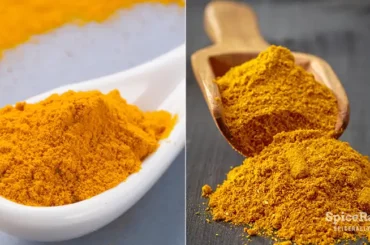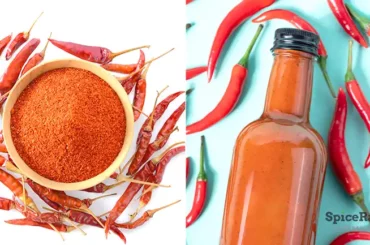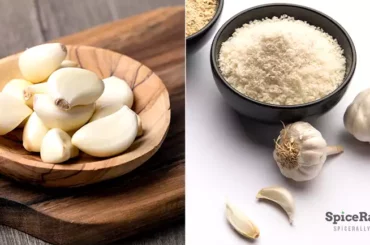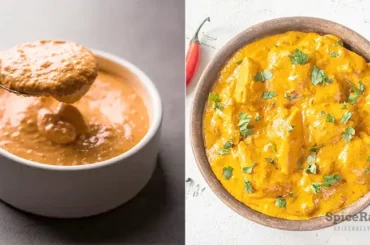SpiceRally readers now know that all spice blends named “curry powder” are different. Thus, we considered elaborating on Sri Lankan curry powder vs. Thai curry powder and explaining how they compare.
The main difference between Sri Lankan curry powder and Thai curry powder comes down to their ingredients and intensities. Thai curry powder confines a brief set of elements, while most Sri Lankan curry powder varieties are complex, with a long list of spices, herbs, etc. Hence, particularly roasted Sri Lankan curry powder variants are spicier and more flavorful than Thai curry powder.
On that note, read further if you have ever wondered what these two spice blends are and how they differ in terms of their uses.

Sri Lankan Curry Powder vs. Thai Curry Powder- SpiceRally DrillDown
| Sri Lankan Curry Powder | Thai Curry Powder | |
|---|---|---|
| Flavor profile | – Most roasted Sri Lankan curry powder types are spicier, piquant and flavorful than Thai curry powder. They hold more profundity with warmer, earthier, and vibrant undertones. – However, Sri Lankan unroasted curry powder can be less spicy, gentle, and less intense than Thai curry powder. | – Generally, Thai curry powder is less intense, powerful, and spicier than Sri Lankan roasted curry powder. It is also less profound, with earthier and pungent flavor elements. – Thai curry powder can be more piquant than Sri lankan unroasted curry powder with a deeper flavor profile. |
| Ingredients | Curry leaves Fenugreek seeds Coriander Fennel Cumin Ceylon cinnamon Black pepper Coconut Uncooked rice Sesame seeds Mysore dal Chana dal Black mustard seeds Cloves Green cardamom Pandan leaves Some types might also include the following: Dried red chiles Garlic Lemongrass Nutmeg Mace Ginger | Turmeric White pepper Cloves Bay leaves Coriander Ginger/ galangal Cumin Red chili flakes/ powder It might also contain the following: Dried basil Onion powder Chili powder Garlic powder Ground nutmeg Dried parsley Ground cinnamon |
| Base flavor | Spicy and warm | Spicy and warm |
| Texture | A fine dry powder | A fine dry powder |
| Heat and spiciness | – Sri Lankan roasted curry powder types are usually more spicy and hot than Thai curry powder. – Unroasted curry powder can be less spicy and hot than Thai curry powder. | – Thai curry powder is less spicy and hot than most Sri lankan roasted curry powder types. – But this can be more spicy and hotter than Sri Lankan unroasted curry powder. |
| Color | – Roasted curry powder is a deep, rich brown in color, while unroasted curry powder has a pale brown shade. – Chicken curry powder has a brownish-black hue, and Jaffna curry powder also holds a deep reddish-brown color. – The roasted depth of coconut and grains defines the color of most roasted curry powder variants. | Typically yellowish-brown in color. The color of Thai curry powder does not usually vary much like Sri lankan curry powder. |
| Mode of usage in cooking | As an ingredient in cooking and as a finishing spice. | As an ingredient in cooking and as a finishing spice. |
| Usage in cooking | – Mainly used in Sri Lankan-style curries – Roasted curry powder is ideal for making meat or fish curries – Jaffna curry powder adds depth to seafood dishes – Jazzes up Asian-style rice dishes – Unroasted curry powder complements vegetable curries | – Often used in Thai-style curries – Used to flavor liquid-based dishes like stews, broths, and soups – Spices up creamy dishes – It can be mixed into groundfish or meat recipes – Ramps up salads and chutneys |
| Origin | Sri Lankan cuisine | Thai cuisine |
| Mode of production | Produced commercially and as homemade options. | Produced commercially and as homemade options. |
| Availability | – Readily available in any grocery shop across Sri Lanka. – It can be found under a few brand names in the international spice aisle of the supermarket, Asian grocery stores, and online shopping sites in Western countries. | – Found across any grocery shop in Thailand. – It can be found under a few brand names in the international spice aisle of the supermarket, Asian grocery stores, and online shopping sites in Western countries. |
| Storage | – It should be stored in glass air-tight spice containers in a cool, dark, dry place. – It can be kept with the rest of the spices in your spice drawer. Refrigeration is not required. | – It should be stored in glass, air-tight spice containers in a cool, dark, dry place. – It can be kept with the rest of the spices in your spice drawer. Refrigeration is not required. |
| Culinary ingredient category | Spice blend | Spice blend |
More Insights To The Difference Between Sri Lankan Curry Powder And Thai Curry Powder
It is not a secret that both Sri Lankan and Thai curry powder give out that fantastic “curry” vibe to many Asian-style dishes. But, it is essential to remember that although they both have some similar ingredients, making them curry powders, they aren’t the same.
Beginning with the fact that they both come from different cooking cultures, they have unique ways of adding depth and flavor to the dishes made in Thai and Sri Lankan cuisines, respectively. As we have represented through the table above, these two spice blends broadly vary in terms of their intensities.
Thai curry powder is more of a generic spice blend used in Thai cuisine, often limited to a brief/similar set of ingredients. Therefore, you’ll experience an invariable intensity and depth in Thai curry powder, regardless of the variations made by each person. But Sri Lankan powder, conversely, usually has a varying potency, mainly depending on the proportions of the ingredients used in named variations.
For example, the intensities of roasted and unroasted varieties are entirely different. You’ll not usually find ingredients like turmeric powder in Sri Lankan curry powder. Likewise, we don’t typically get curry powder, pandan leaves, or roasted grains and lentils in Thai curry powder.
Accordingly, you will savor more robustness in the roasted Sri Lankan curry powder version than in classic Thai curry powder. And interestingly, Thai curry powder is more piquant than Sri Lankan unroasted curry powder. Therefore, although both spice blends are used in making curry, you will experience the dissimilarity in flavor and profundity of those dishes to be completely different.
So, if you are interested in discovering the ultimate substitutes for these spice blends, you can refer to the individual articles. Links are shared below:
Can Thai Curry Powder Be Used In Place Of Sri Lankan Curry Powder And Vice Versa?
Despite the differences these two spice blends possess, they can take charge of each of their duties in curry making when used mindfully. They share some essential ingredients, such as coriander, cumin, cloves, and black pepper.
Therefore, Thai curry powder can replicate the flavor of Sri Lankan curry powder in milder curries that call for the original blend as a secondary ingredient. You could also use Sri Lankan unroasted curry powder instead of Thai curry powder.
Both can swap places for each other, especially in certain vegetable dishes and mostly in meat, fish, or other seafood recipes. However, you should remember that there are better options than using Thai curry powder instead of Sri Lankan curry powder and vice versa.




